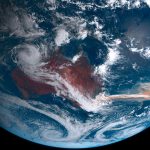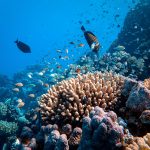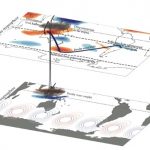 November 24, 2021 12:44 pm
Published by Jenny Rislund
November 24, 2021 12:44 pm
Published by Jenny Rislund
Strong ocean currents are found on the western side of the ocean basins, which flow from the tropics toward the poles in both hemispheres. These western boundary currents have shown strong changes in the last few decades, resulting in intensified ocean warming and are projected to amplify further in the future.
 November 24, 2021 12:09 pm
Published by Jenny Rislund
November 24, 2021 12:09 pm
Published by Jenny Rislund
90% of the heat trapped on Earth by anthropogenic greenhouse gasses is absorbed by the ocean, with the unfortunate by-product of thermosteric sea level rise - as the ocean warms, it expands. Therefore, it is essential that we can accurately measure how much heat the ocean is absorbing over time.
 October 1, 2021 9:42 am
Published by Climate Extremes
October 1, 2021 9:42 am
Published by Climate Extremes
This review brings together a new understanding of the ocean-atmosphere system in the Indian Ocean since the last comprehensive review, describing the Indian Ocean circulation patterns, air-sea interactions and climate variability.
 September 27, 2021 1:55 pm
Published by Climate Extremes
September 27, 2021 1:55 pm
Published by Climate Extremes
In this paper, as part of the Future Seas project, the researchers built upon previous work by using a foresighting scenario analysis technique to envision two alternative possible futures for society by 2030, in the context of the challenge of climate change adaptation and mitigation.
 September 16, 2021 8:26 am
Published by Climate Extremes
September 16, 2021 8:26 am
Published by Climate Extremes
The Australian bushfires of the 2019/2020 summer had far-reaching effects. It has now been revealed in new research published in Nature that the smoke produced a phytoplankton bloom larger in area than all of Australia, thousands of kilometres away in the Southern Ocean between New Zealand and South America.
 September 9, 2021 12:41 pm
Published by Climate Extremes
September 9, 2021 12:41 pm
Published by Climate Extremes
Coral bleaching events have been reported over the Great Barrier Reef during La Niña events and the neutral phase of the El Niño–Southern Oscillation, when large-scale sea-surface temperatures may be cooler than normal. How does this occur?
 September 8, 2021 4:42 pm
Published by Climate Extremes
September 8, 2021 4:42 pm
Published by Climate Extremes
Predicting how much primary production will further increase in the Arctic Ocean in coming decades depends on the interplay between the increase in light for primary producers, as the sea ice extent and thickness decrease, and the availability of food in the form of nutrients, such as nitrate, phosphate, and silica.
 September 8, 2021 4:09 pm
Published by Climate Extremes
September 8, 2021 4:09 pm
Published by Climate Extremes
Using model simulations of the movement of tuna distributions across the tropical Pacific subject to projected ocean changes, the researchers found that without strong mitigation efforts, tuna distributions are likely to shift away from island fishing zones.
 August 27, 2021 11:25 am
Published by Climate Extremes
August 27, 2021 11:25 am
Published by Climate Extremes
CLEX researchers have overturned a scientific paradigm that has existed for 50 years. New research published in Nature Geoscience shows the massive convection caused by the ocean just north of Australia, causes a chain reaction that is strong enough to put an almost permanent dent in the powerful winds that circle the Antarctic.
 July 14, 2021 2:23 pm
Published by Climate Extremes
July 14, 2021 2:23 pm
Published by Climate Extremes
This study looks at 6 months of under-ice zooplankton observations from the N-ICE2015 expedition from January to June 2015 in the Eurasian sector of the Arctic Ocean north of Svalbard.










